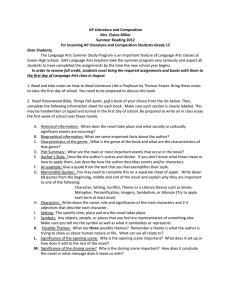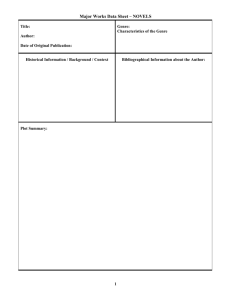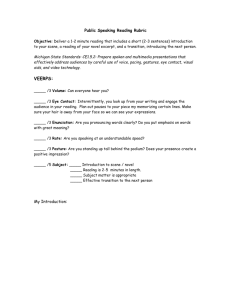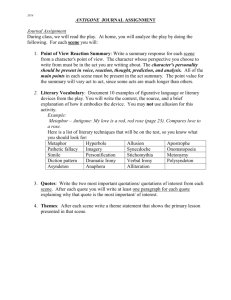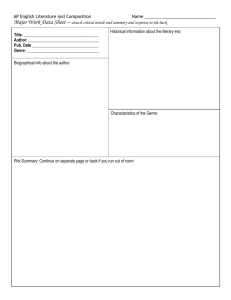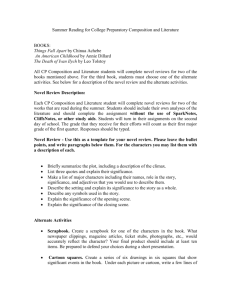Major Works Data Sheet Page 2
advertisement
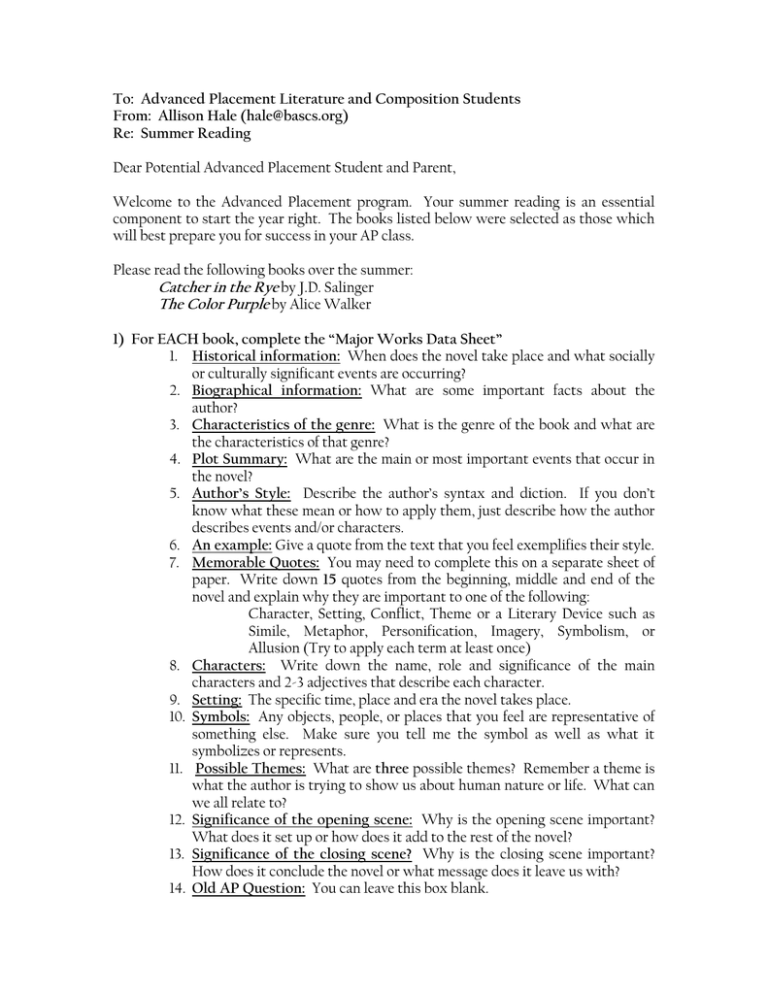
To: Advanced Placement Literature and Composition Students From: Allison Hale (hale@bascs.org) Re: Summer Reading Dear Potential Advanced Placement Student and Parent, Welcome to the Advanced Placement program. Your summer reading is an essential component to start the year right. The books listed below were selected as those which will best prepare you for success in your AP class. Please read the following books over the summer: Catcher in the Rye by J.D. Salinger The Color Purple by Alice Walker 1) For EACH book, complete the “Major Works Data Sheet” 1. Historical information: When does the novel take place and what socially or culturally significant events are occurring? 2. Biographical information: What are some important facts about the author? 3. Characteristics of the genre: What is the genre of the book and what are the characteristics of that genre? 4. Plot Summary: What are the main or most important events that occur in the novel? 5. Author’s Style: Describe the author’s syntax and diction. If you don’t know what these mean or how to apply them, just describe how the author describes events and/or characters. 6. An example: Give a quote from the text that you feel exemplifies their style. 7. Memorable Quotes: You may need to complete this on a separate sheet of paper. Write down 15 quotes from the beginning, middle and end of the novel and explain why they are important to one of the following: Character, Setting, Conflict, Theme or a Literary Device such as Simile, Metaphor, Personification, Imagery, Symbolism, or Allusion (Try to apply each term at least once) 8. Characters: Write down the name, role and significance of the main characters and 2-3 adjectives that describe each character. 9. Setting: The specific time, place and era the novel takes place. 10. Symbols: Any objects, people, or places that you feel are representative of something else. Make sure you tell me the symbol as well as what it symbolizes or represents. 11. Possible Themes: What are three possible themes? Remember a theme is what the author is trying to show us about human nature or life. What can we all relate to? 12. Significance of the opening scene: Why is the opening scene important? What does it set up or how does it add to the rest of the novel? 13. Significance of the closing scene? Why is the closing scene important? How does it conclude the novel or what message does it leave us with? 14. Old AP Question: You can leave this box blank. 2) Create a Literary Terms Dictionary. This must be placed in a 3 Ring Binder that you will bring to class the first day of school. We will be using this binder to organize all your materials for class in order to prepare you to study for the AP test. See the hand-out for directions. Possible websites: a. http://www.tnellen.com/cybereng/lit_terms/ b. http://www.academic.brooklyn.cuny.edu/english/melani/lit_term.html Please don’t just cut and paste the definitions. Put them in your own words so you will understand their meaning. **Make sure to leave space between each term for notes you’ll take in class. Summer Reading Grades: When you return in the fall I will check your Literary Terms Dictionary and the Major Works Data Sheets to be completed on the first or second day of class. You will also receive points for having your 3 Ring Binder. You will be tested on the two novels within the second week of school. I realize that both of the summer reading texts can be easily obtained online and that you could complete the “Major Works Data Sheet” without reading the book. But you will be given a past AP essay prompt that will be impossible to complete unless you have actually read the texts. Please do not attempt to write an AP Essay on a book you haven’t read-it will not go well. Good Luck, and remember it’s never too early to start your summer reading! Literary Terms Directions: Create a Literary Terms Dictionary by defining the following terms. Take extra care to create a dictionary that you may reference throughout the school year. It is highly suggested that you type the definitions. You will be asked to reference these terms throughout the school year. Leave a couple lines below each term in case you want to add future notes or examples. 1. 2. 3. 4. 5. 6. 7. 8. 9. 10. abstract allegory allusion ambiguity analogy anecdote antagonist archetype atmosphere characterization 11. 12. 13. 14. 15. 16. 17. 18. 19. 20. 21. 22. 23. 24. 25. 26. 27. 28. 29. 30. 31. 32. 33. 34. 35. 36. climax concrete conflict connotation denotation denouement dialect diction dramatic irony epic euphemisms exposition extended metaphor falling action farce figurative language flashback foil foreshadow genres hyperbole imagery irony juxtaposition metaphor mood 37. 38. 39. 40. 41. 42. 43. 44. 45. 46. 47. 48. 49. 50. 51. 52. 53. 54. 55. 56. 57. 58. 59. 60. 61. motif narrator onomatopoeia oxymoron paradox personification persuasion plot point of view protagonist realism repetition resolution satire setting simile situational irony speaker style symbol syntax theme tone understatement verbal irony AP English: Literature & Composition Name ______________________________ Major Works Data Sheet Biographical information about the author: Title:_________________________________ Author:_______________________________ Date of Publication:____________________ Genre: _______________________________ Historical information about the period of publication: Plot summary: Characteristics of the genre: Major Works Data Sheet Describe the author's style: Page 2 An example that demonstrates the style: Memorable Quotes Quote Significance Major Works Data Sheet Page 3 Characters Name Role in the story Significance Adjectives Major Works Data Sheet Page 4 Setting Significance of opening scene Symbols Significance of the ending/closing scene Possible Themes
